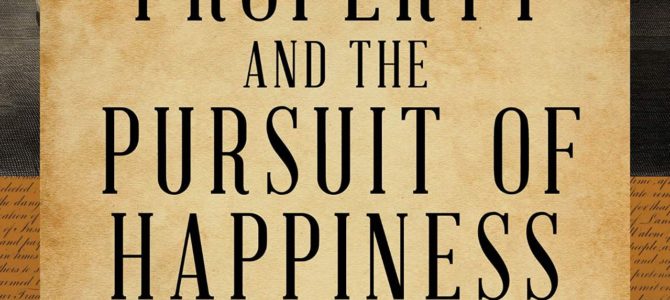
Within our constitutional framework, property rights have been relegated to second-class citizenship.
Take the Supreme Court’s double-standard on the Fifth Amendment’s prohibition against the government “taking” private property unless it’s for “public use.” For alleged infringements of other guarantees in the Bill of Rights, the Court “strictly” scrutinizes government action. But with the Fifth Amendment’s property protections, the Court allows legislatures to interpret their own constitutional boundaries. If “only” property rights are at stake, then the fox may guard the henhouse.
Or consider the Court’s amorphous review for “substantive due process,” a values-based inquiry into the constitutional legitimacy of state and federal regulatory laws. On this score, the Court candidly concedes that property rights and contractual freedoms enjoy less protection than other, non-economic liberties.
In his new book Property and the Pursuit of Happiness: Locke, the Declaration of Independence, Madison, and the Challenge of the Administrative State, Edward Erler shows how constitutional property rights climbed through the looking glass and came out topsy-turvy. From America’s founding era to the present day, property rights flipped from cachet to low-caste, and what’s supposed to be up, well, is down.
Progressives vs. Property
Erler is a professor of political philosophy, so it’s unsurprising this book’s foremost contribution is its discussion of the vital role property rights played in the Framers’ constitutional vision. Tracing an arc of political thought from Aristotle through Locke on to the Declaration of Independence, Erler argues that the Founding Fathers put an inherently American gloss on pre-existing conceptions of property – one that merged natural rights and moral obligation into a synthesis they called “the pursuit of happiness.”
For the Founders, the right to property was the “comprehensive right that included all other rights.” In this spirit, the Supreme Court in 1795 averred that “the right of acquiring and possessing property, and having it protected, is one of the natural, inherent and unalienable rights of man.”
Erler explains the decline of property rights from these sanctified heights. As the economy advanced and governments grew, vested property interests came increasingly into conflict with public policy, and it fell to the courts to demarcate the boundaries between public and private spheres.
For much of our nation’s history, as courts wrestled with these controversies, they hewed to an understanding of property rights closer the Framers than what we see today. The practical result was that property rights enjoyed considerable constitutional protection from overbearing government.
But the scales of justice shifted early in the twentieth century, when “the Progressive forces of history” swept first into legislatures and then into the courts. Progressives rejected the Founders’ conception of property rights because it impeded the “science” of economic planning. As Progressive influence waxed, property rights waned.
Although Property and the Pursuit of Happiness overlaps in subject and tone with Richard Epstein’s excellent 2008 book, Supreme Neglect: How to Revive Constitutional Protection for Private Property, the two books are complementary but not the same. Discussion of the Founding Fathers is largely absent from the latter—arguably the only flaw in Epstein’s seminal work—and this topic is Erler’s strongest contribution.
This is not to say that Property and the Pursuit of Happiness is flawless. In the introduction, Erler warns that he “test[s] the patience of the reader on some occasions,” and he’s not lying. The book is needlessly difficult. Relatedly, he peppers his prose with awkward sentence introductions (e.g., “In a statement that is not entirely hyperbolic . . .”). Further, the book’s subtitle, which mentions “the Challenge of the Administrative State,” engages in a bit of false advertising, as Erler gives the topic only a cursory examination.
Notwithstanding these drawbacks, Property and the Pursuit of Happiness is an important contribution to a growing body of scholarship pushing for a restoration of property rights to their original place among our individual freedoms—particularly with respect to the Fifth Amendment’s Takings Clause.
Taking Root
The good news is that these ideas are taking root. To wit, the Trump administration is reshaping the federal judiciary with a generation of judges affected by Richard Epstein’s work. On the other side of the bar, dogged public interest lawyers—most notably those at the Pacific Legal Foundation—have advanced property rights in courts across the country. After decades, all this effort is paying off.
Consider the blowback to the Supreme Court’s infamous holding 15 years ago in Kelo v. City of New London, which allows government to condemn peoples’ homes and give their land to a corporation in the name of “economic development.” As Ilya Somin explains in his book The Grasping Hand, many state courts reacted to Kelo by tightening restrictions on the use of eminent domain.
Last Summer, the Court handed down a watershed decision in Knick v. Township of Scott, which basically puts property rights (and Fifth Amendment takings claims, specifically) on the same procedural footing as other guarantees enumerated in the Bill of Rights. The Court’s newest members, Justices Neil Gorsuch and Brett Kavanaugh, joined Chief Justice John Roberts’s Knick opinion. The holding is a bold step towards ending the inequality of our constitutional rights.
None of these welcome developments would have happened absent the toils of scholars and practitioners who laid the foundations for a resurgence of property rights. With Property and the Pursuit of Happiness, Erler adds a valuable voice to this worthy cause.









